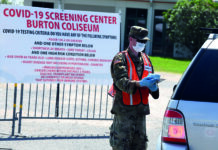As the COVID-19 crisis continues to unfold and affect every sphere of our lives, the threat resulting from climate change is heavily emphasised in every political discourse on the international scene. While the atmosphere, oceans and lands get warmer each year, ice melts and ocean levels rise; deadly disasters like wildfires, heat waves, and flooding are becoming increasingly destructive.
Growing Issue
The effects of climate change are now visible in every corner of the world, with more and more countries suffering from severe weather events. Most recently, the World Meteorological Organization underlined that “2021 is a make-or-break year for climate action, with the window to prevent the worst impacts of climate change—which include ever more frequent more intense droughts, floods and storms—closing rapidly”. Still, human nature has developed a habit of responding to threats, rather than trying to prevent them, while a lack of common perspective and action leaves all of us more vulnerable.
We are at the most dangerous crossroads of our human existence. We no longer face singular threats that we can counter individually, using one-size-fits-all strategies. Today, most of the threats we are facing are so-called “wicked” transboundary threats that no longer require just one approach, but rather force us to learn new ways to cooperate beyond the borders of our lands, political convictions, organisations, and scientific disciplines. Now, more than ever, we need to come up with solutions that are adaptable, fast, context-oriented and, more than everything – transboundary. And today, I challenge you to think of “climate change” using a different set of lenses.
“Comprehensive Security” vs. “Transboundary Threats”
During my first months at the US border with Mexico, as part of the academic team in the Department of Public Administration and Security Studies at the University of Texas Rio Grande Valley, I understood once more that, although the defence industry is one of the biggest investments world-wide, “security” is no longer just about a state, its military power, and the threat level. Danger no longer comes in one simple form, but rather in complex “wicked” covers – as our academic department tries to map it nowadays. Moreover, teaching security becomes a challenging task that does not lend itself to international relations and “security paradigms”.
Moreover, discussing “security” at the time of global crisis is nothing other than trying to find a path in a minefield: pandemic, climate change, environmental disasters, migration, economic reset, cyclic conflicts and unrest, extremism reloaded and a deepening lack of trust in our societies. Therefore, I dare you to look at climate change beyond the ongoing debate and see it as a “wicked transboundary threat” that can only be understood and tackled in the framework of “comprehensive security”.
Evolving Language
Used officially for the first time by former Japanese Prime Minister Ohira, the term ‘comprehensive security’ breaks the limited requirements of military defence against a particular ‘enemy’ and stresses the need to consider other aspects vital to national security, such as food, energy, environment, communication, and social security. While not denying the importance of military security, “comprehensive security” explicitly encompasses a wide range of other aspects, like the search for environmental security, for instance, which requires cooperation with other countries. The concept stresses the need for confidence building methods as a requirement for its attainment and pertains to issues such as preventive diplomacy, energy security, second order cybernetics, and greater transparency of international financial markets as a means to enhance overall stability. Moreover, “comprehensive security” provides the right platform to overcome the limited simplifications such as ‘us’ and ‘them’.
In the same way, “transboundary wicked issues” represent major challenges for evaluation as they cross not only the geographical/physical boundaries, but also to the academic/field specific and political/governmental limitations. In this regard, a “wicked transboundary threat” becomes a “cube-faced” issue that is no longer specific to just one certain country and government, political group or organisation, neither to just one certain discipline, requiring cooperation beyond the identified limitations.
Climate Change and Security
Scholars and scientists have analysed the “tragic governance” of climate change and defined it as a “super wicked” problem that comprises “four key features: time is running out; those who cause the problem also seek to provide a solution; the central authority needed to address it, is weak or non-existent and, partly as a result, policy responses discount the future irrationally”.
Although the four reasons provided are undisputedly true, they do not describe the whole picture of climate change. The security threat represented by climate change fits into the category of complex wicked problems that truly transcend boundaries and distinctions between cause and effect, local and global problems, facts, and impressions. As a “complex wicked transboundary” threat, climate change is no longer part of the realm of local challenges and uncertainty, but rather globally connected events and ambiguity.
Climate change is not only intractable in terms of contested knowledge and expertise, contested values and unpredictability, but also in terms of its potential as a threat multiplier that can exacerbate existing trends, tension, instability, territorial and geopolitical struggles. Additionally, climate change is interwoven with issues (such as climate refugees) and is characterised by potential consequences for peace and security, including:
- border disputes
- instability surrounding migration
- impact on energy supplies
- food and water shortages
- social stresses in weak states
- humanitarian crises from drought and flooding
Changing Landscape
Due to its complexity, transboundary wickedness requires a different evaluation perspective that acknowledges the following:
- any type of boundaries are unclear, shifting and constantly redrawn, based on context and the continuous evolution of events
- collaboration and cooperation, trust and learning prove various flaws and the realm of distrust, coalitions and imagination are repetitively activated
- the traditional paradigm of “us” versus “them” becomes an impediment in tackling these kinds of threats
- strategic communication and comprehensive understanding of the issue are key elements in developing a common perspective of the threat, beyond our previous limitations.
Bearing in mind these elements that are vital for both the management, as well as the evaluation of transboundary issues, here comes the hardest question: What is an appropriate evaluation and management approach for the international governance of a complex wicked transboundary problem such as climate change?
Current Threats and Opportunities
Currently, global temperatures have risen about 1.8°F (1°C) from 1901 to 2020, sea level rise has accelerated from 1.7 mm/year throughout most of the twentieth century to 3.2 mm/year since 1993, glaciers are shrinking and the average thickness of 30 well-studied glaciers has decreased by about 20 metres since 1980.
Furthermore, the area covered by sea ice in the Arctic at the end of summer has shrunk by about 40 per cent since 1979, plus the amount of carbon dioxide in the atmosphere has risen by 25 per cent since 1958, and by about 40 per cent since the Industrial Revolution (Global Climate Dashboard). Beyond these facts, the most dangerous side of global warming stays in its threat multiplier potential:
- increased conflict and state fragility
- mass migration
- tense competition and struggles for scarce resources
- a trend toward nervous self-preservation
- introspection and even militarisation on the part of major powers
- disruption to the international trading system
- more complex risk management in strategic planning
Due to its impact on existing local, regional, national, and international vulnerabilities, many argue that climate change can become a more serious security challenge than any other issue. While climate change is “officially” prioritised in political discourse and policy documents both by national governments and international organisations, concrete steps fail to follow the over-emphasised declarations. Worldwide, governments have had to tackle more pressing issues and short-term crises, leaving “climate security” on stand-by.
Diplomacy
Although the need for international cooperation is acknowledged as a foundation to the complex wicked transboundary issue of climate change, there are still states that show signs of being tempted by a logic of isolationist self-reliance. Moreover, important branches of security such as conflict, migration, military and defence industry, economic security, and food security, have failed in fully integrating the implications of climate change towards their own fields. We are still far from understanding the direct and indirect relations between the real facts of the “complex wicked transboundary climate change threat” and the effects in the larger sphere of “comprehensive security”.
Instead of drawing and trying to comprehend the bigger picture, we still limit ourselves to a fragmented approach that affects our long-term potential to tackle the current catastrophe, not to consider the next disaster. In addition, the longer it takes us to take the next steps from acknowledgement to practice, the fewer chances we have to survive the next disaster. And despite the threat it represents, climate change can also be an extraordinary opportunity for us to develop better ways to communicate and cooperate beyond physical, political, psychological, and scientific borders.
Recommendations
Bearing in mind the complex nature of the issue, at the international level, an integrated approach to climate change should be part of developing strategies related to conflict, migration, military, defence, and economics. Thus, climate-related factors should be considered in the prediction and prevention of conflicts, including by improving governance in already resource-stressed states. Moreover, bearing in mind the current events, the world needs an international climate-induced migration prevention and management strategy that anticipates migratory flows and potential security risks, while tackling all the issues based on transboundary cooperation.
Further on, as the defence industry and military have proved during the extraordinary developments in recent times, there is an increased need to draw the line between militaries’ engagement with climate security. In this regard, a broader understanding of the connection between defence requirements and the effects of climate change is necessary to develop defence equipment and military strategies to engage effectively with a broader range of climate-related challenges.
Role of Security
Nevertheless, there is another side of the relationship between the security sector and climate change, as empirical evidence also shows that all over the world security sectors are often part of the problem themselves, contributing to, or aggravating climate-related security crises through poor governance practices and sometimes also through direct or indirect involvement in illicit activities that are harmful to the climate and the environment. The security sector also contributes directly to global warming, with military forces being among the largest emitters of greenhouse gases and consumers of fossil fuels in the world. Therefore, an assessment of these factors should be considered in the future management of security vs. climate change challenge.
Last, but not least, the geo-economics of climate change forces governments to balance commitment to free trade and their desire to access resources and renewables while avoiding mercantilist policies. Currently, climate change is affecting the security of food in the most vulnerable regions across the globe and the key element to tackle it is cooperation. As communities in every corner of the world are affected independently in different ways, and at different levels, the domino effect of this threat is enormous and moves faster than we can adapt. This, once again, is another characteristic of its wicked transboundary nature that requires a different set of solutions, based on mostly on transnational, transgovernmental, transorganisational and transdisciplinary cooperation.
Conclusion
So far, the assessment of the threat posed by climate change towards international security has failed to reflect its complexity. As a wicked transboundary issue, climate change needs a new approach that acknowledges all its characteristics together with its threat multiplier potential. Therefore, the issue of climate security should go from being a topic of political discourse, to a key aim of international action that forces closer cooperation between states, governments, organisations, and scientific disciplines. With our own future at stake, we have no other option than to cooperate and go beyond our borders to create a common, better, and safer tomorrow.










